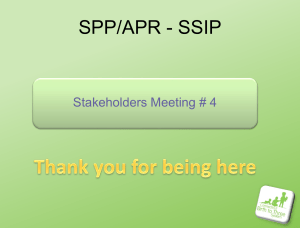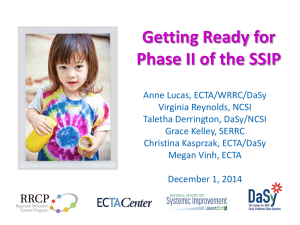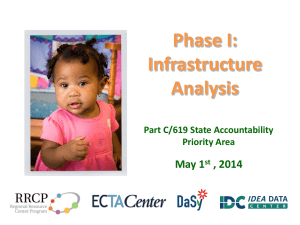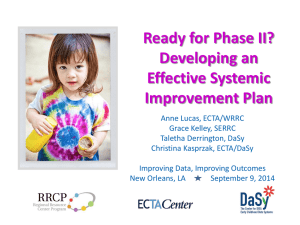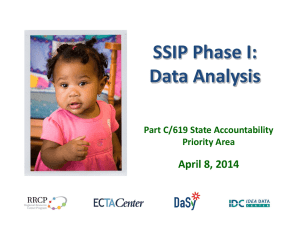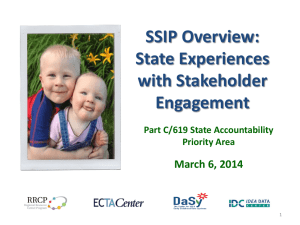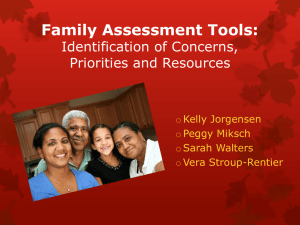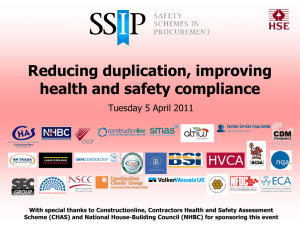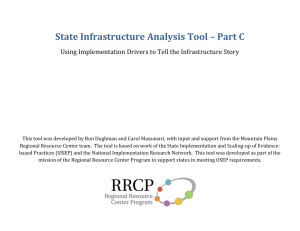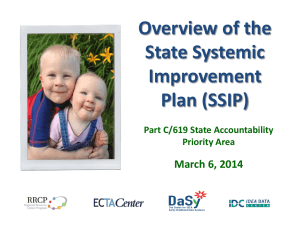The Role of Data in Improvement Planning
advertisement
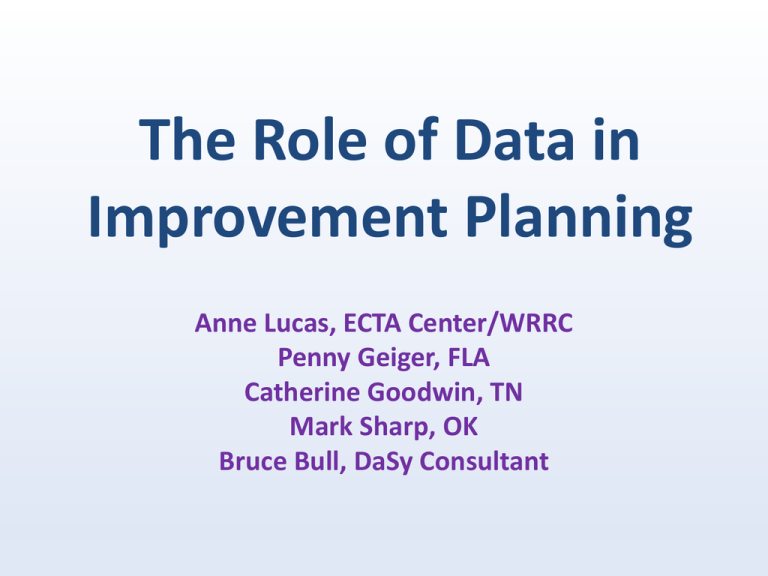
The Role of Data in Improvement Planning Anne Lucas, ECTA Center/WRRC Penny Geiger, FLA Catherine Goodwin, TN Mark Sharp, OK Bruce Bull, DaSy Consultant Session Agenda • Overview of Proposed SSIP • Proposed TA Resources to be developed • 3 States’ efforts (TN, FLA, OK) • Discussion 2 Proposed Indicator C-11 (SSIP) • INDICATOR: The State’s SPP/APR includes a State Systemic Improvement Plan that meets the requirements set forth for this indicator. • MEASUREMENT: The State’s SPP/APR includes a comprehensive, multi-year State Systemic Improvement Plan, focused on improving results for infants and toddlers with disabilities and their families. Adapted from SERRC 2013 3 Proposed SSIP Activities by Phase Year 1 - FFY 2013 Delivered by Feb 2015 Year 2 - FFY 2014 Delivered by Feb 2016 Years 3-6 Phase I Analysis Phase II Plan Phase III Evaluation • Data Analysis; • Identification of the Focus for Improvement; • Infrastructure to Support Improvement and Build Capacity; • Theory of Action • Infrastructure • Results of Ongoing Development; Evaluation • Support for local • Extent of Progress educational agency (LEA) • Revisions to the Implementation of SPP Evidence-Based Practices; • Evaluation Plan FFY 2015-18 Feb 2017- Feb 2020 4 Proposed RRCP Priority Area TA Resources • SSIP Talking Points for use with stakeholders • Proposed Timeline for SSIP Activities • SSIP Process Framework • Guiding Questions • Web-based Support (slide decks, short lessons) 5 Proposed RRCP Priority Area TA Resources • Quantitative Data Resources: – Compiling data analysis currently available – Developing SSIP decision flow chart – Developing a how-to guide for planning data analysis (companion to flow chart) 6 Proposed RRCP Priority Area TA Resources • Qualitative Data Analysis – Developing White paper on analysis of qualitative data – Providing Case Studies • Theory of Action – Describing uniform process for working with stakeholders to develop Theory of Action – Adapting general frameworks to reflect SSIP – Providing options for displaying Theory of Action – Developing checklist to ensure achieves desired results – Developing an Evaluability Assessment 7 Potential Other TA Resources • Reference Guide Concerning Data Collection, Review and Analysis (MSRRC) • ECTA Systems Framework 8 OKLAHOMA INDICATOR 11 BUILDING OUR ROAD MAP WHAT I HEARD CONSIDER ALL DATA WALLOW IN THE DATA DEVELOP YOUR MAP Oklahoma’s Process Step 1:Stop the drama and start looking at our map with the destination driving our actions. Our Destination Our Mission Oklahoma’s SoonerStart Early Intervention program builds upon and provides supports and resources to assist family members and caregivers to enhance children’s learning and development through everyday learning opportunities. Now we know our destination – how do we measure it? We choose to measure the 8 key principles that build upon our mission statement. Key Principle #1 Early Intervention services for children and families are most effective when agencies and organizations work together to provide services based on families needs. Interagency Agreement Interagency Contract for services Agency(s) participation in ICC meetings SoonerStart Family Survey Child Find data Service delivery by each agency by region Timely services 45 day timeline Key Principle #2 Infants and toddlers learn best through everyday experiences and interactions with familiar people in familiar context. EI Database – Services provided in natural environments. SoonerStart Parent Survey - Caregiver involvement satisfaction Early Childhood Outcomes Data Data on where children spend their days Settings data Key Principle #3 All families with the necessary supports and resources, can enhance their children’s and family’s learning and development. SoonerStart Parent Survey - Caregiver involvement satisfaction Early Childhood Outcome results IFSP Review of supports and services outside of SoonerStart - eg: CSHCN, food stamps, medicaid etc Number of local staff trained on the Routine Based Interview (RBI) and usage rate with families IFSP content – Resources provided to families Key Principle #4 The primary role of the service provider in early intervention is to work with and support family members and caregivers in children’s lives. SoonerStart Parent Survey - Caregiver involvement satisfaction SoonerStart service delivery approach Documentation in progress notes Promised services in relation to services provided Number of local staff trained on the Routine Based Interview (RBI) and usage rate with families Family goals written on the IFSP Provider caseload Key Principle #5 The early intervention process, from initial contacts through transition, must be dynamic and individualized to reflect the child’s and family’s preferences, learning styles and cultural beliefs. Team use of the RBI SoonerStart Parent Survey Review of family concerns and priorities Compare against services that are provided on IFSP Number of local staff trained on the Routine Based Interview (RBI) and usage rate with families Complaint and Due Process Hearing data Key Principle #6 IFSP outcomes must be functional and based on children’s and family’s needs and family identified priorities. SoonerStart Parent Survey - Caregiver involvement satisfaction Number of local staff trained on the Routine Based Interview (RBI) and usage rate with families Review of IFSP using tool to assess such as Missouri IFSP review tool IFSP goals reflect child and family identified needs Early Childhood Outcome Data Complaint and Due Process Hearing Data Key Principle #7 The family’s priorities, needs, and interests are addressed most appropriately by a primary provider who represents and receives team and community support. Review of local team composition (staff and contract) Community collaboration – Early Head Start / Head Start Interagency Agreements Documentation of team input on IFSP and other documents Number of local staff trained on the Routine Based Interview (RBI) and usage rate with families SoonerStart Parent Survey Key Principle #8 Interventions with young children and family members must be based on explicit principles, validated practices, best available research, and relevant laws and regulations. IFSP Promised services compared to IFSP services delivered. Monitoring and compliance data Complaint and Due Process Hearing Data Professional development provided for staff on various services delivery issues, review of higher education curriculum and inclusion of EI principles Next Steps Collect and analyze data Involve stakeholders ICC Partner Agencies Oklahoma State Department of Education Use data to determine Area of Focus Catherine Goodwin Part C Monitoring Coordinator Tennessee Department of Education 25 Mystery Presenter 26 Results-Based Monitoring for Improvement is an opportunity to update and align TEIS work and efforts to the broader work of the TDOE to increase performance of all students. RBMI takes advantage of TEIS location within TDOE to coordinate with both 619 and Part B. 27 Results-Based Monitoring for Improvement 28 1. TEIS Topic Selection 2. Point of Entry (POE) Selection 3. Administer Improvement Strategy Tool with POE(s) 4. Develop POE Improvement Plan 5. Implement the Improvement Plan ► TEIS Technical Assistance Efforts ► POE Efforts ► Local Provider Efforts 6. Ongoing Measurement Until Criteria 29 Topic selection is supported by recently updated content in the Revised TN Early Learning Developmental Standards (TN ELDS) Birth-48 Months. These pre-academic concepts align with the broader work and focus of IDEA Part B SSIP and TDOE’s efforts to improve all student performance through consolidated and results focused ESEA/IDEA/fiscal monitoring. 30 Revised Tennessee Early Learning Developmental Standards: Birth – 48 Months 31 Florida Florida Department of Health Children’s Medical Services Early Steps Penny Geiger, Bureau Chief We are what we do repeatedly. Excellence, therefore is not an act but a habit. Aristotle SSIP Beginning Steps Spring 2012 Closer look at disaggregated data Move from data reporting to possible improvement strategies Family Outcome Data Family Survey - NSCEAM Local Early Steps Programs interested in their results (15 regional local lead agencies) What did scores mean Relationship between three outcome areas measured Each program identifies priority items from survey based on results Process for family survey optimized Child Outcome Data Tool - Battelle Developmental Inventory, 2 First look at data: Children enter typical, exit not typical Social/Emotional data Child Outcome Data Hypothesis 1. Positive social, consistent relationships are base from which developmental potential is possible 2. Social/Emotional skills not sufficiently addressed unless deficit area 3. Providers have limited knowledge/strategies to address social/emotional needs of child/caregiver dyad Conclusion Social/Emotional development identified as area of focus Additional Data Analyzed disposition data Increased number of “Lost to Follow Up” Hypothesized 1. Compliance requirements may have unintended consequence – close instead of engaging family 2. Family engagement from referral to exit is critical to get positive results from early intervention Conclusion Family engagement is identified as area of statewide focus. Next Steps Engage broad stakeholder group to analyze the data and review focus areas to develop plans for improvement Questions ? Discussion • What data do you have to analyze for your SSIP? • What concerns, if any, do you have with those data? • What might be done to reduce concerns? (E.g., address validity concerns.) • How might data improvement be addressed pre SSIP, during SSIP development, and after SSIP is in place? • If you were sitting on top of the PDH (perfect data heap) what data would you analyze? What would that analysis look like? What might it take to get there . . . or part way there? 41 Discussion • Which proposed resources do you think would be most helpful? Why? • Least helpful? Why? • What additional SSIP resources would you suggest be considered for development? 42 Discussion • What types of SSIP evaluation activities might be considered? • Who would be involved in the evaluation? • What stakeholders might you consider bringing into the SSIP fold? • What roles would stakeholders be expected to have in SSIP development? • In the ongoing SSIP? 43 Contact Us Catherine Goodwin, TN Catherine.Goodwin@tn.gov Bruce Bull, DaSy Consultant bruce.bull@spedsis.com Penny Geiger, FL penny_geiger@doh.state.fl.us Anne Lucas, ECTA/WRRC Anne.Lucas@unc.edu Mark Sharp, OK Mark.Sharp@sde.ok.gov 44
